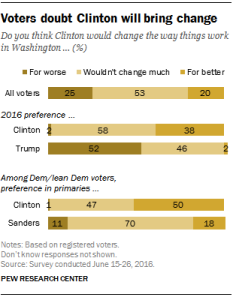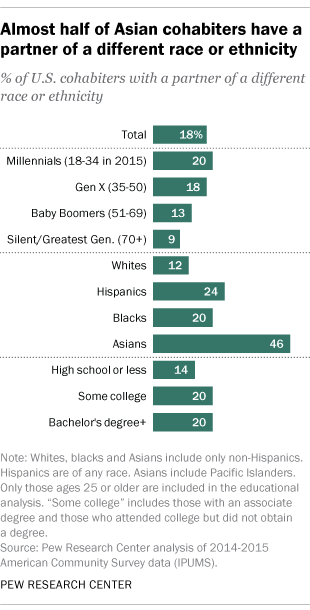

A half-century after the Supreme Court legalized interracial marriage in the United States, 18% of all cohabiting adults have a partner of a different race or ethnicity – similar to the share of U.S. newlyweds who have a spouse of a different race or ethnicity (17%), according to a new Pew Research Center analysis of U.S. Census Bureau data.

Among cohabiting U.S. adults – those living with an unmarried partner – Millennials and members of Generation X are particularly likely to have a live-in partner of a different race or ethnicity: Roughly one-in-five in each group do. The rates are significantly lower among cohabiting Baby Boomers (13%) and members of the Silent Generation (9%).
Cohabitation, while still relatively uncommon, is on the rise in the U.S. as marriage is declining. In 2015, 6% of all U.S. adults were living with a partner, while half of adults were married.
Of the major racial and ethnic groups, white adults who are in a cohabiting relationship are the least likely to be living with a partner of a different race or ethnicity (12%). This share rises to 20% among black cohabiters and 24% among Hispanic cohabiters. These rates are very similar to intermarriage rates among white (11%), black (18%) and Hispanic (27%) newlyweds.
The story is different for Asian adults who cohabit. Almost half (46%) are living with a partner of a different race or ethnicity. This is far higher than the share of Asian newlyweds who are intermarried (29%). One factor that might partially explain this difference is that a larger share of Asian cohabiters (39%) than Asian newlyweds (25%) were born in the U.S., and U.S.-born Asians are more likely than those who are foreign born to have a spouse or partner of a different race or ethnicity. (Among Asian immigrants who cohabit, 38% have partners of a different race or ethnicity compared with 59% of Asian cohabiters who are U.S. born.)
Like their newlywed counterparts, cohabiters with more education are somewhat more likely to have a significant other of a different race or ethnicity. While 14% of those ages 25 or older with a high school diploma or less are living with a partner of a different race or ethnicity, the share rises to 20% among those with at least some college experience. Among newlyweds, 14% with a high school diploma or less are intermarried, as are 18% of those with some college and 19% of those with a bachelor’s degree or more.